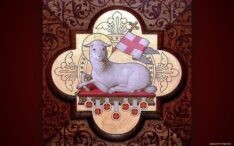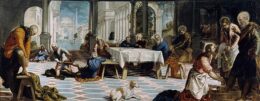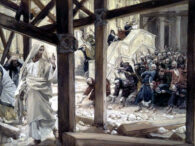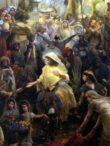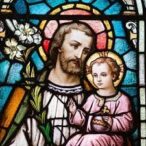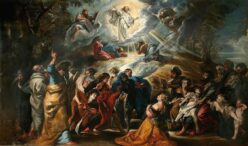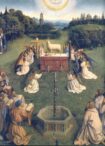With the Resurrection, in a moment, the history of the world was changed. And in a moment, the character of the music of the liturgy correspondingly changes.
The ceremonies of the Paschal Vigil prepare us for this glorious transition. Our first indication that things are about to change occurs when the priest, after blessing the New Fire and the Paschal Candle, and in preparation for the Solemn Procession into the church, removes the violet vestments and dons white ones. He wears white for the Procession and the Exultet. He changes back to violet for the Lessons and the First Part of the Litany, and then back again to white for the Renewal of the Promises of Baptism, after which he and the servers leave the church while the Second Part of the Litany is chanted.
The priest reenters the church in white vestments for the Mass of the Paschal Vigil. There is no processional hymn because we are moving directly from one liturgical function to the next. The Prayers at the Foot of the Altar and the Introit are omitted and Mass begins as soon as the priest enters the church with the unaccompanied chanting of Kyrie I, Lux et Origo, which is designated for use In Paschal Time.
The priest then intones the Gloria(likewise from Mass I), and the glory of it is unmistakable as the organ sings once again after a long silence, the bells ring out, and the statues are unveiled.
After the Epistle, we welcome back the Alleluia in grand fashion. The priest chants it to a beautiful and elaborate melody, and it is then immediately repeated by the schola. The priest sings it again at a higher pitch, and it is again repeated by the schola. The priest sings it a third time at still a higher pitch, and the schola again repeats it. The schola then immediately sings the versicle Confitemini, which is immediately followed by the Laudate, which, interestingly, is referred to as a Tract.
The Credo is not sung because it had previously been recited at the Vigil during the Renewal of the Promises of Baptism. There is no Offertory antiphon. The Agnus Dei is omitted because it had previously been recited during the Litany. There is no Communion antiphon.
This one time during the year, Lauds (which in this instance is very brief) is combined with the Mass and is begun as soon as the priest finishes with the ablutions. It consists simply of an antiphon, Alleluia, sung three times, Psalm 150, and the characteristic Canticle of Zachary, with the antiphon Et Valde Mane.
There is no Last Gospel, and the recessional begins immediately after the Last Blessing.
At the Offertory, the Schola sang the masterpiece of Saint Venantius Fortunatus, written in the year 604, Salve Festa Dies. The words to the simple refrain are quite moving:
Hail, great day, in all time most worthy of veneration, for today God conquered Hell while holding his place among the stars.
At the Communion, the full choir sang Palestrina’s setting for the Sicut Cervus, a canticle from this same liturgy. After our customary recessional, The Strife is O’er, the ladies’ choir sang the hymn from the Eastern Rite liturgy, Christos Anesti.
